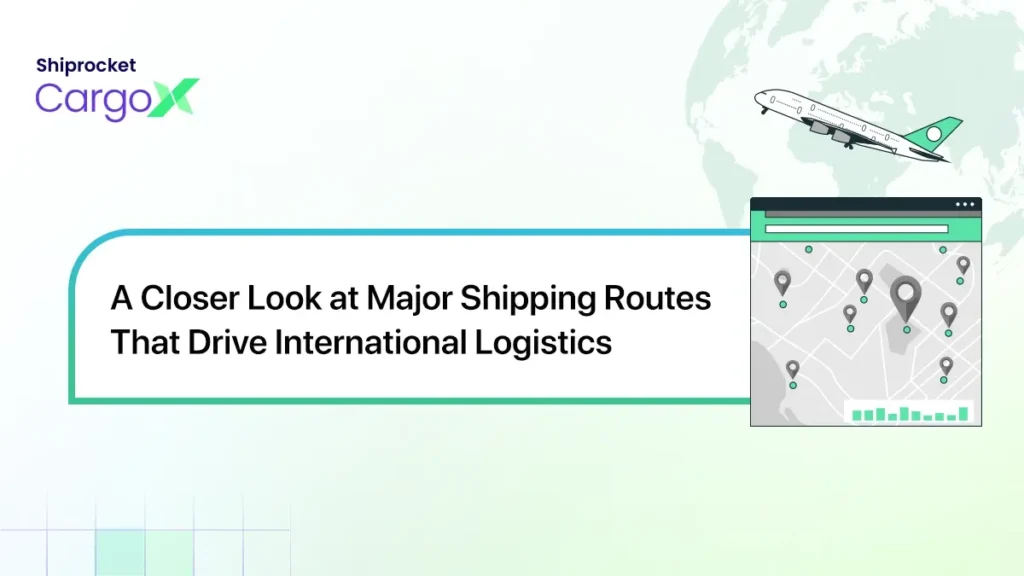Global Shipping Lanes and Routes: Guide to International Logistics
International shipping lanes & routes are the lifeblood of international logistics, ensuring that goods and materials move efficiently across continents. These maritime highways connect countries and continents, forming a network that powers global trade. Without these lanes, transporting goods between distant regions would be slow and costly.
At the heart of the world’s trade network lies maritime shipping. It remains the most relied-upon mode of transportation for international cargo. Most global goods (around 90%) are moved by sea, making naval routes essential to the smooth operation of international business. While air and ground transport are also critical, ocean shipping is the backbone of large-scale trade.
Shipping lanes are vital for the global economy. Massive ships carry billions of products annually, traversing routes that are carefully engineered for efficiency and speed. These routes are well-established, but congestion is higher around major trade hubs due to heavy traffic. As ships move along these lanes, ports play a pivotal role in ensuring that the flow of goods is uninterrupted, enabling timely deliveries across the globe.
Ports, freight forwarders, and carriers are essential components of the system, supported by digital services like container tracking that keep global trade running smoothly. They all contribute to a well-organised structure that allows global trade to flourish. Shipping lanes are more than just ocean routes; they form the foundation of the global economy, ensuring international commerce operates efficiently.
With this in mind, let’s discuss some of the crucial international shipping lanes & routes that serve as the foundation of business worldwide.
The Most Important 5 Shipping Routes for Global Trade

Shipping routes are vital channels that enable the movement of shipments worldwide. They connect key countries and regions, ensuring seamless trade. Here are the five most important international shipping lanes and routes.
1. The Panama Canal – Linking Asia and the United States
The Panama Canal is a direct route for vessels moving between Asia and the United States. This canal joins the Atlantic and Pacific Oceans, significantly reducing travel distance. Ships save between 2,000 to 8,000 nautical miles, reducing shipping time by several weeks.
This artificial waterway has become one of the most important corridors for maritime trade. Expanded in 2016, it now accommodates larger vessels, handling up to 14,000 TEUs (twenty-foot equivalent units). The increased capacity allows for more cargo, leading to greater efficiency in the shipping industry. Nearly 15,000 ships pass through the canal yearly, making it a busy and essential route for goods moving between Asia and the US East Coast. The canal also serves vessels trading between the eastern and western Americas.
Although this route is highly efficient, its narrow locks restrict daily vessel traffic, resulting in delays for some ships. The canal operates through a lock system that raises ships using water from a lake. These limitations can cause vessels to anchor for extended periods, sometimes days or weeks. However, ongoing expansions aim to address this by adding new locks on both sides to accommodate the next generation of container ships.
2. The Suez Canal – Connecting Asia and Europe
The Suez Canal provides a crucial link between Asia and Europe, providing the shortest and fastest way to travel between the two continents. It joins the Mediterranean Sea with the Red Sea, bypassing the need for ships to travel around Africa’s southern tip. This reduces travel time from weeks to just a few hours. Over 100 ships used the canal daily in 2023, underscoring its importance to global trade.
The canal’s importance was particularly highlighted in 2021 when a huge container ship accidentally blocked it, causing significant disruptions to trade and a sudden increase in crude oil prices by 4%. Despite its vulnerability to blockages, the Suez Canal remains indispensable. Its strategic location makes it a major route for transporting oil, particularly from the Middle East to Europe. The shortened route reduces emissions and shipping costs, making it a popular choice for shipping lines.
The Suez Canal sees the transit of some of the largest container ships in the world. The canal’s role in global trade continues to grow as trade volumes between Asia and Europe increase. This waterway remains vital not only for container ships, oil tankers, and other vessels carrying essential commodities like crude oil and liquefied natural gas.
3. The English Channel – A Lifeline for Europe and the United Kingdom
The English Channel is crucial in shipping between Europe and the United Kingdom, forming a vital link between the North Sea and the Atlantic Ocean. With over 500 ships passing through it every day, it ranks among the busiest international shipping lanes & routes globally. This channel also connects the UK to major ports in North America, making it a central route for goods coming from across the Atlantic.
The English Channel’s short transit time makes it ideal for ships carrying food, fuel, and manufactured goods between Europe, the UK, and the rest of the world. The busiest part of the channel is at the Strait of Dover, where vessels must follow carefully regulated shipping lanes, similar to vehicles moving on a two-lane highway.
While the English Channel is efficient for maritime traffic, its narrow width at specific points can be challenging. However, its critical role in connecting multiple regions ensures its importance for the foreseeable future. This is particularly true for countries heavily reliant on trade routes to sustain their economies.
4. The Strait of Hormuz – Key for Middle Eastern Oil
The Strait of Hormuz is a major artery for shipping, especially for oil exports from the Middle East. Positioned between Iran and Oman, this strait sees over 20 million oil barrels passing through daily. It remains one of the most important global shipping routes, facilitating the transportation of fossil fuels to Europe, Asia, and the Americas.
The volume of oil passing through this narrow waterway highlights its strategic importance. Not only do oil tankers rely on this route—cargo ships carrying essential goods also pass through the Strait of Hormuz. Due to the immense amount of oil transported through this region, any disruptions can profoundly impact global markets.
The Strait of Hormuz has consistently ranked as one of the busiest maritime channels. In recent years, it has witnessed more than 20,000 vessel transits annually. Given its pivotal role in transporting energy products, this strait will likely remain an indispensable shipping route for decades to come.
5. The Strait of Malacca – Gateway to Asian Markets
The Strait of Malacca is a primary maritime route between the Indian and Pacific Oceans. It connects some of Asia’s largest economies, including China, Japan, and India, with the rest of the world. Over 50,000 vessels pass through the strait annually, handling approximately one-quarter of the world’s maritime traffic.
Stretching between Indonesia, Malaysia, and Singapore, this 550-mile-long waterway is critical in global trade. Its strategic location makes it a crucial route for goods from Asia to Europe and the Middle East. The strait also plays a vital role in transporting energy products, particularly oil and gas, from the Middle East to Asia. Nearly 30% of the world’s trade passes through this narrow shipping lane each year.
The Strait of Malacca’s low width makes it difficult for bigger vessels to pass, even though it is important economically. Even so, it continues to be one of the busiest and most important commercial routes in the world, allowing products to be moved between major markets in Asia, Africa, and the Middle East.
These five shipping routes are fundamental to business globally, connecting major economies and facilitating the movement of goods worldwide. Each route has its features and challenges, from the English Channel’s narrow confines to the vast oil flow through the Strait of Hormuz.
The efficiency of these routes is critical for keeping global supply chains running smoothly. Any disruption, whether due to accidents, political instability, or natural disasters, can have far-reaching consequences. As international trade continues to grow, so will the importance of maintaining and upgrading these vital shipping lanes.
CargoX: Mastering Global Shipping
CargoX, integrated with Shiprocket, enhances global logistics through its air cargo shipping service. This feature allows businesses to send bulk consignments swiftly across borders without worrying about international regulations. Together, they simplify international shipping by handling all necessary documentation and offering fast delivery to over 100 global destinations.
By understanding global shipping, you can confidently expand your brand internationally, supported by a platform that simplifies logistics and enhances operational efficiency.
Conclusion
Knowing the international shipping lanes & routes helps you find the most efficient paths, reducing costs and improving delivery times. As global trade evolves, staying adaptable is critical. Regularly reviewing strategies and embracing new technologies will help businesses remain competitive. With reliable partners like CargoX, companies can ease their logistics operations and efficiently respond to changes in the industry. Ultimately, informed decision-making will lead to successful outcomes in the complex world of international shipping.





